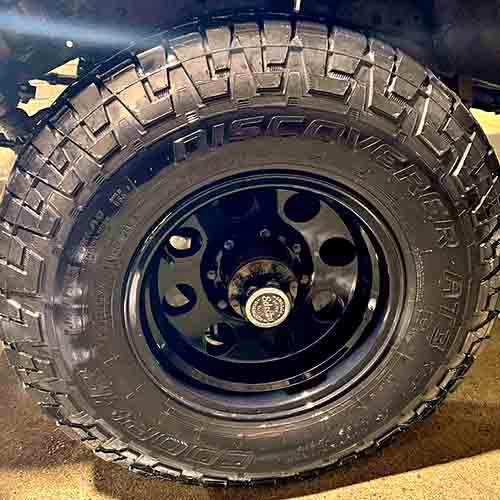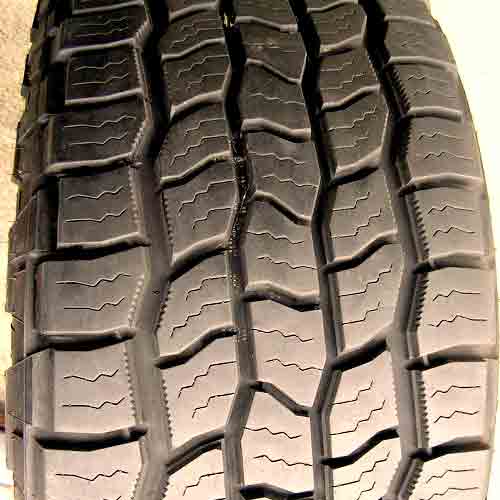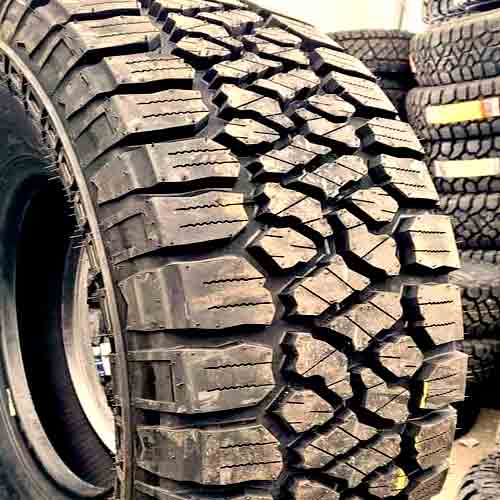Both the Kenda Klever AT2 and the Cooper Discoverer AT3 XLT have been designed with advanced tread compounds that deliver superior off-road performance. However, the choice between the two can be difficult. So let me compare the technical specifications and performance data of both tires to determine which one is the better choice (for you). Let’s begin!

In my expert opinion as a tire engineer, the Kenda Klever AT2 besides providing a great budget option does better on wet and snowy terrains. Moreover, it’s off-road traction is also greater, especially on rocks and mud. The Cooper AT3 XLT on the other side, is superior with noise, comfort and tread wear on roads, and on rugged terrains, it renders superior sand traction, comparatively.
Side Note: Make sure you check out my list of top A/T tires, if you haven’t yet. It would help with your decision a lot. You can also reach out to me directly, just like both tire’s steering, I am also pretty responsive. Wink.
Table of Contents
Available Sizes
The Kenda Klever AT2 provides you with 15 to 20 inches rim diameters with following specs:
- Speed ratings: R, S, T and H
- Load ratings: SL, XL, C and E
- Weight range: 35 to 60 lbs
- Tread depth: 14/32″ or 15/32″
- Ratings: 3PMSF and M+S rated
- Warranty: 50k (LT), and 60k for P metric sizes
Review this tire in detail: https://tiredriver.com/kenda-klever-at2-review/
Moving towards the Cooper Discoverer AT3 XLT, this tire comes with 32 sizes in total (15″ to 20″ rim sizes) and they have following specs.
- Load range: C to F
- Speed ratings: either R or S
- Weight range: 44 lbs to 70 lbs
- Tread depth is seen to be either 16.5 or 17/32″ in all sizes
- All sizes have 60k miles warranty
Detailed Review of Cooper AT3 XLT: https://tiredriver.com/cooper-discoverer-at3-review/
Tread Design
Starting with Cooper Discoverer AT3, let me device this in two sections, middle (part of the tread) and the shoulders).

In the middle:
- There are 3 circumferential ribs here, making four vertical grooves.
- All lugs in these ribs have interlocking sipes and foundational secondary rubber layers.
- In the center most, the blocks are slightly wider, and this offers on-road directional stability.
- The outer ribs are made to handle off-road in a better way as they also carry one extra feature of saw-toothed biters on edges.
On shoulders:
- Comparatively, the blocks are bigger here, making elongated design. And so because of that the sipes on them are also longer, though they still make somewhat similar pattern.
- These lugs are serrated towards outer edges, and make thick sidewall lugs with mud scoops, though in comparison to Kenda Klever AT2, they are not thick enough, nor they provide ample traction, even with lowered air pressure.
Note: The sidewall lugs are the main features which differentiates the Cooper AT3 XLT, from the Discoverer LT and the Discoverer 4S, (the other variants of this tire, before it only used to be under just one “Cooper AT3”).
On the other side, the Kenda Klever AT2 gives you a completely different design.

In the middle:
- The lugs here are not as big in comparison.
- They are all equipped with rectilinear sipes, off-set edges and sharp sides.
- These biters provide off-road traction, where as the ridges connecting the lugs together offer on-road stability.
- These ridges also act as stone ejectors as well, keeping the tread clean.
On sides of the tread:
- Shoulder lugs are bigger, covering most of the area of tread.
- They have different (more interlocking sipes).
- Their outer margins are staggered having mud scoops.
- The tire also makes sidewall biters (which are very squared off).
Pavement Performance
To assess the dry performance of an all-terrain tire, traction, steering, and cornering capability are all essential components to consider. Let’s examine each of these key factors in more depth.
Dry Grip
The dry grip of a tire is influenced by several factors, such as rolling resistance, weight, rubber composition, and tread pattern, and considering all the Kenda Klever AT2 gets to have an upper hand here.
The tire features a lighter structure, and smaller tread depth, and it’s inner lugs are more packed up together (where the most weight concentration is on, while rolling straight). So it shows up with short braking distances.
Cooper Discoverer AT3 XLT on the other hand, although has the advantage of longitudinal arrangement of the lugs, it’s overall grip is still lacking (by a small margin though), because of it’s heavier weight, which forms greater moving inertia and hinders the overall stopping efficacy.
Are All-Terrain Tires Good For Daily Driving? : https://tiredriver.com/are-all-terrain-tires-good-for-daily-driving/
Dry Handling
Handling or lateral traction of a tire depends on shoulders. But why is that?
Well, because as the tire turns, the weight of it’s structure, and the vehicle, it carrying, gets shifted towards the outer parts of the tread, and how well they meet up with the road is very crucial.
That’s why with wider lateral grooves seen between the shoulder blocks of Kenda Klever AT2, the tire gets to be lacking.
Cooper Discoverer AT3 XLT on the other side, not only offers a larger contact patch from there, it’s lugs are also more stable, as they have connectors in between. This keeps the blocks firm as the tire corners, not allowing them to bend too much and impact steering response as much as the Klever AT2 does.
Ice and Snow Traction
Both tires ahve 3 peak mountain snowflake symbols and they really deserve it.
This rating basically tell you that the tire is 10% better in “acceleration” compared to average all-season tire. I’ve talked about it more here.
The Kenda Klever AT2 basically offers smaller lugs in the middle forming interlinked structure, with haphazardly placed blocks. This provides great snow trapping abilities, which then makes a better snow to snow contact.
Snowflakes basically stick better on each other, so this type of contact is significant (that’s why we have the phrase “the snowball effect”).
Snow sticks better on snow, basically, that’s why , so this type of contact is much preferable here.
On the other side, the Cooper Discoverer AT3 XLT although is not able to grip in a better way, it’s still not too far off, as it’s outer longitudinal grooves provide you with snow vices (specialized saw-tooth biters made for holding snow).
And it’s softer rubber composition, also keeps it’s sipes much more malleable even with freezing temperatures.
For Your Info: In my list of top A/T tires, most efficient tire on snow is Mickey Thompson Baja Boss A/T (review).
Wet Traction
A tire’s wet performance is split into two parts: wet traction and hydroplaning resistance. Let me talk about them both.
Wet Grip
Improved traction and stability on wet roads is achievable with a tire that incorporates both siping and flexibility in its tread design. And both of these tires do a great job in providing those.
Kenda Klever AT2 with it’s new gen compound, and dual siping structure (interlocking on shoulders and rectilinear in the middle), yield great handling and braking abilities on wet roads.
Whereas on Cooper Discoverer AT3 XLT you also get an interlocking structure of sipes everywhere combined with a softer tread compound which provide these sipes with enough flexibility so they can expand to slurp in water particles coming underneath.
Yet, the tire is still lacking overall, if you consider the second part of wet performance. See below.
Hydroplaning
Hydroplaning occurs when the tire is not able to evacuate water from its tread quickly enough, causing it to float and here grooves work against that.
But since the Cooper AT3 has closed up shoulder blocks, with connectors in between, it hinders the water flow towards sideways, whereas the Kenda Klever AT2 with open design and interconnected web of grooves in the middle (part of the tread) renders superior clearing of water, and resistance to aquaplaning.
And less water clearing off through the grooves, means more water is there for the sipes to clear off, limiting overall wet performance.
Fuel Consumption
Fuel consumption is primarily shaped by the flexing of the lugs, so here tread depth, weight and compound composition counts.
That’s why the Kenda Klever AT2 with a lighter structure, and shallower tread depth provides better fuel economy. It’s lugs are less prone to bend, as they don’t get to carry as much weight on them, and they aren’t too deep. So less energy gets wasted in to the flexing of the tread blocks, and more in rolling of the tire.
Cooper Discoverer AT3 XLT on the other hand, besides having a supple compound, has more structure weight, and tread depth on average, so the opposite happens here.
Tread Life
Although rolling resistance and fuel consumption are very closely related, the Cooper AT3 still gets to provide better life comparatively.
This is because even though the tire faces a higher burning rate (of the tread blocks), it still takes more time for it’s tread depth to reach down to 2/32″ legal limit.
In comparison, the Klever AT2 with tread depth reaching up to 15/32″ supplies shorter tread life.
Do A/T tires wear faster?: https://tiredriver.com/do-all-terrain-tires-wear-faster/
Tire’s Toughness
Durability is crucial for off-road tires, as they need to withstand rough terrain, which includes a lot of puncturing stuff, including sharp logs, thorns, and of-course stones (at least these are the ones I experienced).
So in order to handle this, these tires are given with stronger inner construction. Though both tires have the same toughness here.
They both have 2 ply polyester casing covered with 2 steel belts with just a single ply of nylon.
Mud Traction
Muddy terrains demand tires with better self cleaning abilities.
And out of both tire, you see that better on Klever A/T2. The tire does not offer conventional longitudinal ribs and instead provides mud with multiple pathways, with it’s interconnected grooves joining up with wider longitudinal channels.
Moreover, unlike its competitor, the tire also features open shoulder blocks, that account for better sideways mud evacuation.
The Cooper AT3 on the other side, has closed up shoulder lugs, and it’s ridges there (whisper grooves) restrict the flow of the mud laterally.
Rock Climbing
On rocks, besides durability (especially on the sidewalls), you also need a lot of biters, so a tire can grip in multiple directions (highly needed during climbing).
That’s why here the Kenda Klever AT2 is doing better with it’s haphazardly placed central blocks of various geometry, forming in groove biters (with off-set edges on these lugs), and yielding multiple-angled grip.
Cooper Discoverer AT3 XLT on the other side, has a very blocky structure, and although it’s outer lugs/staggered edges help it’s overall traction, (with lowered air pressure values), it’s still not enough to outperform its competitor).
Are A/T tires good for rocks? : https://tiredriver.com/are-all-terrain-tires-good-for-rocky-terrains/
Ride Quality
Two critical elements play a role in determining the quality of a ride – the tire tread noise and the tire’s ability to manage road imperfections through its tread composition and structure. I’ll examine each of these factors in more detail.
Comfort (From Bumps)
The road comfort provided by a tire is connected to its ability to absorb road shocks and vibrations, and it gets determined by its composition.
But since both tires, have similar compositions (meaning, they are equally soft), there’s only tread depth left to explain why the Cooper AT3 is a better tire here.
A greater tread depth means more rubber thickness between you and teh bumps, and so with this tire reaching up to 17/32″, the Kenda Klever AT2 with depth up to 14/32″ isn’t able to provide as much area for the imperfections of the roads to settle down.
Tread Noise
Noise from tires is just the result of air flow, mostly through the grooves on the shoulders of the tire’s tread, this air then hits the walls of the tread producing tread noise.
The Cooper AT3 deals with this in a better way, as it features Whisper Grooves Technology, which is just a fancy word for placement of ridges/connectors between the shoulder blocks.
These connectors where provide stability on roads, also account for resisting air particles to come in to the tread in the first place.
The Kenda Klever in comparison with its open shoulder lugs, is not able to provide similar noise dampening.
Are All-Terrain Tires Noisy? : https://tiredriver.com/are-all-terrain-tires-noisy/
Take Home Points
Overall its safe to say that both tires have their good and bad.
The Kenda Klever AT2 gives superior wet and winter grip, and off-road its better on rocks and mud (mild terrains).
Whereas the Cooper AT3 does better with comfort (in terms of noise mostly), and its brings superior tread life. Moreover off-road, you’d be impressed by it’s much better sand traction.